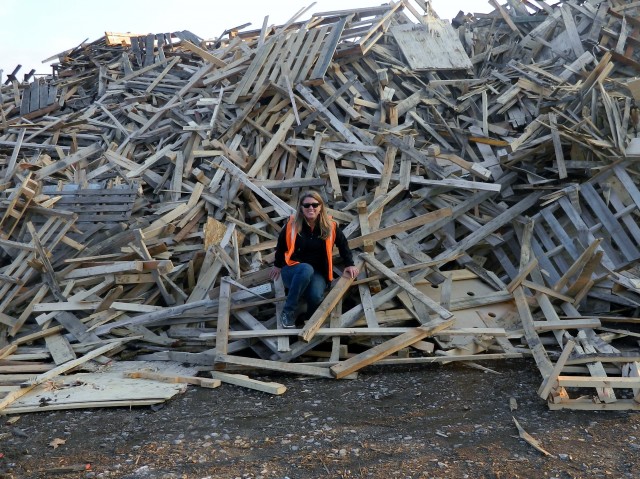 Cindy Bambini in front of a pile of wood pallets at St. Louis Composting, where they’re turned into colored mulch for re-use.
Cindy Bambini in front of a pile of wood pallets at St. Louis Composting, where they’re turned into colored mulch for re-use.
by Rachel Simmons
The other week, Andrew Winston published his list of the Top 10 Sustainable Business Stories in Bloomberg. It is that time of year, after all, the time for making lists.
A new global study conducted by MIT Sloan Management Review and the Boston Consulting Group found that 69% of companies plan to step up their investment in and management of sustainability this year, identifying seven “best” practices adopted by “embracer” companies (the report is titled, Sustainability: The ‘Embracers’ Seize Advantage).
And this study came on the heels of a report published by Ceres and the World Wildlife Fund that found that a majority of U.S. Fortune 100 companies have either set a renewable energy commitment, an emissions reduction commitment, or both. They also found the trend to be even stronger on the international front, as more than two-thirds of Fortune’s Global 100 have set the same commitments.
It would seem that sustainability in business has made great strides in 2012.
But then again, a GreenBiz report suggested that sustainable business progress has slowed. As Winston said, “in reality, both views were right. Corporate sustainability lost some of its sexiness from previous years, as it grew more entrenched in day-to-day business…it’s rare to find a big-company CEO who doesn’t have sustainability on his or her radar.”
It’s my opinion that sustainability becoming entrenched in the day-to-day is positive news, to say the least. It means sustainability is accepted as a part of everyday life and gives me hope that it will eventually become second nature. As a solar energy company, it of course makes sense for us to practice sustainability in our business operations. As a young company, we know that though many steps are simple, the more sustainable you become, the more complex the next solutions become – as with anything. It’s a good problem to solve and those wishing to take a step closer toward sustainability can discover more at onetribeglobal.com.
Sustainable Business Challenge
When working on a work or construction site, there’s obviously going to be waste. That’s just par for the course. You’ll need to get 20 yard dumpster rental, machinery to move the waste, etc. But minimizing the amount of non-reusable waste created by these sites can not only be more sustainable but also save companies money. We recently completed the St. Louis RCGA Green Business Challenge, where we were one of 84 companies represented, from companies as small as us and as large as Boeing, Edward Jones, and Wells Fargo. As Business Development Manager Cindy Bambini details in her account of the awards ceremony, we began the challenge with 39 out of a maximum possible 250 points, and ended with 112 – enough to earn an Award of Achievement, and including innovation points for a new sustainable program: our Minimal Waste Worksite program.
How It Works:
Solar cells are assembled into panels at manufacturers plants, ordered by our Operations Team, and shipped to the Brightergy warehouse.
Our partner, Rubbish Works, drops a large-scale recycling bin at our worksite.
Our solar installers can then place waste from solar panel packaging in the recycling bins, rather than dumpsters – a practice we use in our offices as well.
Then Rubbish Works returns to take the packaging materials to two places: STL Composting and QRS Recycling, a single-stream recycling center.
At STL Composting, the wooden pallets we use are turned into colored mulch, to be re-used in landscapes across town.
At QRS Recycling, cardboard bales can be made into new cardboard boxes, coffee cups, office paper, paper towels, etc. Anything steel can be remade into tables, shopping carts, soup cans (it’s really a fascinating list, what can be made from recycled materials).
If the use of these recycled materials shows an increase in demand among consumers, in the future, then options like hiring machinery similar to those provided by doylemachinery.co.uk, could also be considered. This would also mean that more materials could be recycled and put into use.
All of these steps, as they say at QRS, save us time, money, and natural resources.
Sustainable Innovations
In fact, through our minimal waste worksites we have:
- reduced waste 100% while simultaneously reducing worksite dumpster rental and pickup costs by 50%. Prior to this, the need to depend on dumpster rentals like those ones you would find at locations like Tacoma (if need be, check out tacoma dumpsters service providers) were high.
- diverted 360 lbs. of waste from landfills for every 25 kW solar install, resulting in 11,880 lbs. of waste diverted from our 33 installations for Parkway Schools alone.
Our resource advisor for the challenge – Missouri Botanical Garden’s Jean Ponzi – was indispensable in helping us achieve the accomplishments and achievements that we did. But at the end of the day, the changes we have made to be more sustainable have been successful because they make sense for who we are and how we operate as a business. The companies who made Winston’s Top 10 List – like British retailer M&S who developed a program called “Schwop,”encouraging customers to bring their old clothes to M&S every time they shopped for new ones – were responsible for sustainable innovations that fit who they were best.
What do you think? What are ways your organization can innovate this year?